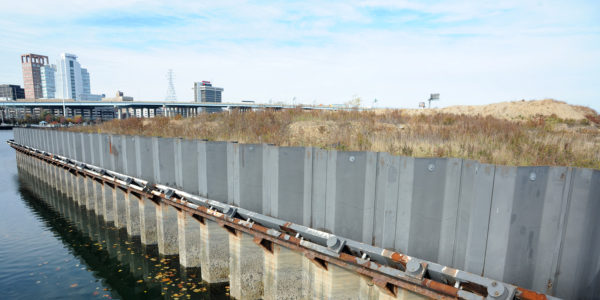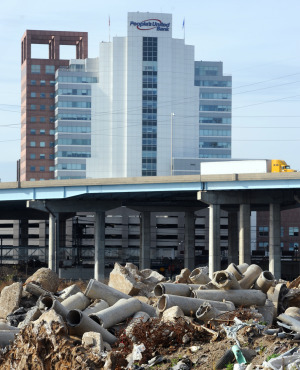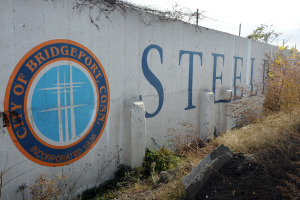Challenges ahead for Steelpointe Harbor redevelopment

- The waterfront bulkhead at Steel Point, the waterfront tract of land along Bridgeport Harbor that is destined to be included in the Steelpointe Harbor development. Photo by Ned Gerard
BY HUGH BAILEY
Hearst Connecticut Media
On a piece of Bridgeport land that sat mostly vacant for two decades, news that tenants have agreed to move in to Steel Point has been welcome. But when it comes to developing the site, that might have been the easy part.
City officials and developers of Steelpointe Harbor, as the site is known, last week announced that Starbucks and Chipotle Mexican Grill plan to join anchor store Bass Pro Shops on the city”™s prime redevelopment project. They are scheduled to open next fall.
But the sites where they will be built, near Interstate 95, do not require major preparatory work. The bulk of planned development ”” residences, a marina, a hotel and more ”” is below Stratford Avenue, where problems include long-buried contaminants in the soil, bulkheads along the waterfront in need of repair and land that was deemed too low to build on because it falls in the 100-year floodplain.
Officials say what is happening now will make that work possible.
“It”™s not as challenging as it may seem for the fundamental reason that a big part of the financing of the project is the TIF district,” said David Kooris, Bridgeport”™s director of economic development. TIF stands for tax-increment financing, a type of bonds that pay for infrastructure work and are repaid using tax revenue generated at the site. Those 20-year bonds, along with a mix of public and private funding, are paying for the development.
“Getting the easy part done first means the lower-hanging fruit has been picked, but it also means we”™ll have real development to fund the TIF,” Kooris said.
Visible progress
Once the foundations for the new stores are in and construction begins, they will be the first visible structures on the northern half of the peninsula since the former home of James Henry O”™Rourke, credited with the first hit in National League history in 1876, was razed in 2009.
The next steps in what is supposed to eventually be a 2.8 million-square-foot development won”™t be as clear to the casual observer.
“What we will see concurrent with the construction is a ramp-up of infrastructure work,” Kooris said. “From out on a boat, it will be really clear. They will be driving piles, starting the dredging and, most visibly, the piles from the old marinas will start getting pulled. The detritus scattered in the harbor will start to be eliminated.”

- Piles of dirt and debris cover Steel Point in Bridgeport, with Interstate 95 and downtown in the background. Photo by Ned Gerard
Starting work on the waterfront has been contingent on moving the last tenants on the peninsula, Hillard Bloom Shellfish, formerly known as Tallmadge Brothers, and Move Yacht Club. The waterfront work is scheduled to be completed in 2016. In the meantime, Kooris said there are prospective tenants in the offing.
“There are dozens of tenants we”™ve been speaking with, and they”™ve become increasingly interested over the years,” he said. “Seeing the anchor aspects come into focus has had a huge impact on the private marketplace.”
Cleanup
The Steel Point peninsula was once the bustling site of homes and businesses, including a 14.5-acre property that was for generations a heavily polluting power plant.
Despite the complications with brownfield cleanups, city officials say they are not concerned because regulations allow some contaminated material to stay on a site as long as it is kept away from human contact.
“As with most brownfields, what you have to do is to get rid of the hotspots, and then it”™s just a matter of capping it,” either with a layer of soil, a parking lot or a building foundation, Kooris said.
Another complication concerned the existing 10-foot waterfront bulkheads, which do not clear federal regulations instituted after Hurricane Sandy flooded much of the Northeast in 2012. The new, higher bulkheads will be 14 feet above the water line.
Bridgeport lobbied unsuccessfully to have the cost of putting power lines under the streets borne by United Illuminating Co. ratepayers. Instead, the work will be funded by the TIF bonds, leaving less money for other work.
“It just means we have to do more with less,” Kooris said. “We are early enough in the process that we have time to adjust.”
The work under the streets has elevated them above the properties on either side, which will have to be raised themselves.
“Filling in development sites with soil or parking does the bulk of the brownfield remediation,” Kooris said. “What we need to do for remediation is also what we need to do for flood elevation.”
Easy access
Once developments are completed, the site will be easy to reach from I-95, and just as easy to get away from. Kooris said it will be the city”™s job to give people a reason to stick around.
“North of Stratford Avenue is the hook that gets people off the highway. It”™s up to us to create a reason to stay. South of Stratford Avenue is a big part of that reason,” including additional shopping and restaurants plus waterfront activities, he said.
Even if fully developed, one concern is the potential isolation from the rest of Bridgeport. The peninsula is separated from downtown by the Pequonnock River, from the East End by the Yellow Mill Channel and from the East Side by an elevated interstate highway. Still, officials say whatever gains it produces can be woven into the wider city.
“There will likely to be some combination of road improvements, sidewalk improvements and streetscape continuation,” Kooris said, citing underpasses below I-95 as in need of better lighting.
He said the city is near a final design for a streetscape connection to downtown, and that development around a planned second train station on the East Side would also help link Steel Point to the rest of the city.
Robert W. Christoph Jr. is vice president of operations of Florida-based RCI Group, whose entities include Steelpointe Harbor developer Bridgeport Landing. He said people are starting to believe the long-standing project is making progress.

- The Steelpointe Harbor logo has been visible for years on a wall that remains from an old industrial structure at Steel Point in Bridgeport. Photo by Ned Gerard
“Everyone”™s heard about it, but for a long time no one really believed it,” Christoph said. “Now they can see it coming.”
The payoff
Maureen McAvey, a senior fellow at the Urban Land Institute in Washington, D.C., said developments of the type envisioned at Steel Point have seen success around the country.
“We”™re increasingly seeing people are attracted to real mixed use, whether it”™s horizontal or vertical, where people work and live with common places and retail,” McAvey said.
But there are plenty of obstacles. “The challenge, like most things, is can they get the details right,” she said. “It”™s complicated because you”™ve got multiple markets, hotels, retail, office ”” are you hitting the markets correctly?”
Housing plays a major role, she said. “Ideally, you want a mix, not too much high-end or low-end. And that”™s true for food, too ”” so many people eat out so many meals in a given week, you want to offer a real mix, from sit-down dinners with tablecloths all the way to some bagels you pick up on the way home.”
McAvey said financing for large deals is always a fraught question. “It”™s a legitimate issue, but then the question becomes the ”˜but for”™ issue ”“ ”˜But for this investment, would this be done anyway?”™ The question becomes, ”˜If we didn”™t do something, would we just have this empty lot this whole time?”™
“If it”™s too big a risk for a developer, the question for the city is whether they”™ve really thought through the appropriate share of risk.”
TIF funding can be controversial because tax revenue from a project is diverted away from the city to pay off the bonds, she said. “It can seem like a long time, but eventually those TIF bonds are paid off,” she said. “So then in 20 years, all that revenue flows to the locality.”
And despite the obstacles, the payoff can be substantial, McAvey said. “If a city is consistent with its focus and there”™s a decent market, it really does turn things around,” she said.
Hearst Connecticut Media includes four daily newspapers: Connecticut Post, Greenwich Time, The Advocate (Stamford) and The News Times (Danbury). See ctpost.com for more from this reporter.